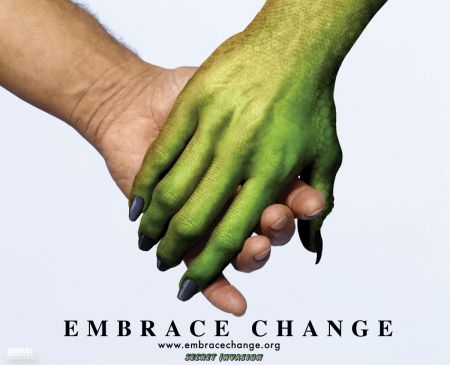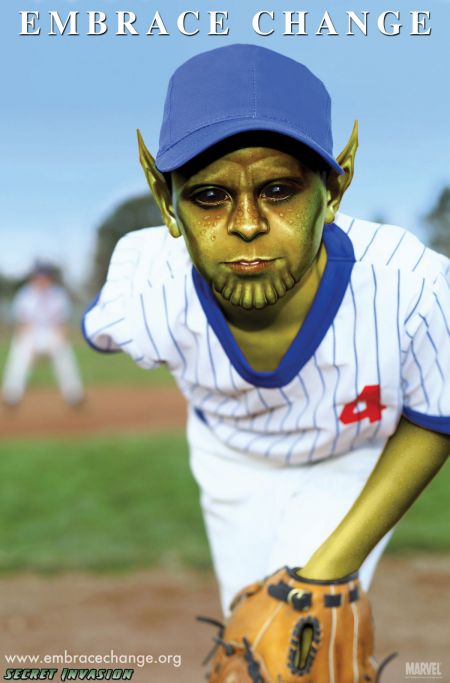Movies /
Comics To Film News
Marvel Comics' Embrace Change Campaign Is Not Effective
By Hervé St-Louis
September 18, 2008 - 09:51
The last time a television advertisement for a comic book was aired in the United States, must have been somewhere during the 1980s to promote the
G.I. Joe comic book series published by Marvel Comics at the time. Back then, animated advertisements created by Sunbow, the same studio owned by Marvel Comics and that produced the animated television show
G.I. Joe and the related action figure advertisements were frequent. Marvel Entertainment has attempted to reach out to the public again, earlier on this week on September 16 2008, with a new campaign promoting a comic book series and crossover. The question is did they fair well?
The one-minute and 23 second short aired on ESPN, a sports network, during the
Bricktown Showdown, a minor league baseball broadcast. The advertisement featured off screen female and a male narrators with pitch effects in their voices explaining to humans how their actions threaten their planet and how aliens from space (Marvel Comics’ shapeshifting Skrulls) were going to rescue humanity and make everything right again.
Several questions arise from the advertisement that can now be seen at Marvel.com’s very own embracechange.org that suffers from redirection problems – it may take you to the regular Marvel.com Website, instead of marvel.com/embracechange.
1-Is the target market public on ESPN2 the right demographic group to be enticed by a television advertisement promoting a comic book series?
2-Is the advertisement effective?
3-Was Marvel Entertainment’s operational skill level sufficient to putting this advertisement on air?
4-Will the advertisement propel viewers to purchase the comic books or enquire about them?
5-Did Marvel Entertainment reach its objectives with the broadcast advertisement and should it air more in the future?
1-Minor league enthusiasts probably are found in smaller cities in the Midwest and Western American states, and smaller Eastern Southern states, such as North Carolina. This public is probably composed mostly of blue collars workers with families and children. They probably own their homes and watch baseball games and support local sport franchises when they are available. The disposable income of this public is probably limited due to the number of children and stretched finances. Wives may or may not work outside the home.The current outlook of the American economy is not favourable to this segment the American public. However, having cable at home means that some frugalities are allowed in the household.
Typical comic book readers’ demographics include teenagers, college students and college graduates that often live in denser urban areas although many of them must come from the same demographic market segment that watches minor league baseball on ESPN2. The typical comic book reader is part of a larger demographic group that may be susceptible to be interested in Marvel Comics, although their numbers is probably lesser than the blue-collar crowd from ESPN2.
I argue that a similar advertisement airing on the Sci-Fi network might yield better results and target a more interested audience with the right amount of disposable income.
2-The advertisement was not clear in its intention and was too long. It should have been as short as 30 seconds and be clear from the onset about what it intended to do. The moralizing should have been kept short and go on the attack about why the Skrulls need to be on Earth after no less than 10 seconds.
As it was designed, the advertisement felt like religious ads for the Church of Latter Day Saints, or something that wanted to make people feel guilt about their behaviour. Most viewers probably perceived it as a cult’s recruitment ad or something from the left-wing media trying to make people quit driving their SUVs to the local mini-mall. Is such a campaign effective, when trying to make people buy your comic books? Wouldn’t a shorter and cleverer ad have been more effective?
Shouldn’t the designers of this ad inserted quick visuals about the Skrulls or Marvel Comics’ iconographic imagery quickly and briefly as Easter eggs to let viewers know that this was a friendly ad that was not really trying to induce guilt and shame?
3-I argue that the ad, using stock imagery and only at the end using high quality graphics showing Skrulls living side by side with humans was not effective and of poor design. Just like the
G.I. Joe advertisements of the 1980s, perhaps Marvel Entertainment should have invested in original film or animation footage to best maximize its message. There’s no point for a media company like Marvel Entertainment to send its message across on a shoestring budget. The advertisement looked like something a first year film student’s montage produced on iMovie.
Marvel Entertainment should have hired a professional advertising agency when it decided to produce this broadcast advertisement to better finetune their message and test, test and test the ad before they released it.
4-The advertisement’s only call to action was to invite viewers to visit a Web site which at the time of the launch redirected people to the wrong address – Marvel.com’s general Web site instead of the targeted one. That no one verified and tested the redirection extensively is incompetence and a waste of Marvel Entertainment’s investors’ money. Such a campaign is not launched unless all components are verified and tested extensively. Even today, I am still redirected to Marvel.com’s main page instead of the specific Web site. Marvel Entertainment should have put embracechange.org on a totally separate Web hosting account or, a subdomain, instead of a directory from Marvel.com, to make sure that users with anti-redirection protection features in their Web browsers would still see the right page, when they visited.
The call to action was not clear enough. It did not mention the name of the comic series
Secret Invasion anywhere in the broadcast advertisement. Although there was a small logo from Marvel.com and
Secret Invasion at the bottom of the advertisement at the end, it was not enough to properly brand the ad and let viewers know that they had to buy the Secret Invasion comic book series. Even the Web site Embracechange.com is vague about where exactly can viewers buy this comic book series. If the call to action is not clear, how can people know what they need to buy in order to follow the secret invasion and read more about the Skrulls?
5-I don’t know what Marvel Entertainment’s objectives for this advertisement were. I read that they are trying to promote the
Iron Man and
Hulk DVD and
Blu-ray releases concurrently which sends different message to the buying public. Neither the recent
Iron Man nor the
Hulk movies are tied with
Secret Invasion. Mixing them is not a good idea. If Marvel Entertainment wanted to interest the wider public in its comic books, they should have stolen a page from their ancestors from the 1980s who specifically targeted a market segment that was right. The
G.I. Joe advertisements aired during kids’ television shows, often during the
G.I. Joe cartoon series! Here, only pre-existing comic book readers who are already aware of the Secret Invasion comic book series may be interested in the advertisement released.
I believe that television advertising is a great way to increase comic book readership and market shares for a publisher like Marvel Comics. However, such advertising must be enacted carefully to maximize exposure and reach the exact target demographic group that is susceptible to enjoy such disposable entertainment before an attempt is made to educate and attract a wider public, as that found on ESPN2. Hence, Marvel Entertainment needs to go back to the drawing table before it comes out with more misdirected broadcast advertisements like its Embrace Change campaign.
Last Updated: March 3, 2025 - 20:40


